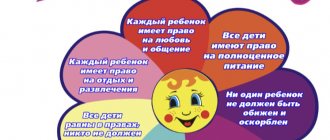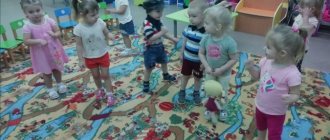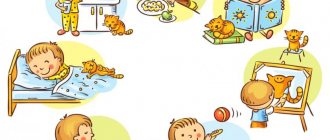Organizational aspects
- It is necessary to unite the children and make friends. This applies to new groups. The guys don’t know each other yet, so it’s better to immediately accustom them to certain rules of behavior in a given place and at a given time. And the easiest way to do this is during playful, creative and entertaining activities.
- In groups where children are already familiar with each other, it is necessary to monitor their relationships, track their social roles, and, if necessary, adjust the behavior of preschoolers.
There is a very simple test.
Children are offered flowers cut out of paper (balls, suns, stars, etc.) of different sizes, from very small to large. And the task is given: choose a flower or an image that is involved in the test, and place it on a sheet of Whatman paper (on a table or some other surface).
The teacher can be the first to take the picture and place it anywhere. Next, you need to analyze the children's choices. Some will choose the largest flowers and place them in the center, others will want to stick the flower closer to the teacher.
Mostly, children place flowers next to other flowers. But there are also those who will choose the smallest flowers and put them in the corner. It is these kids that you will need to pay special attention to. They clearly feel lonely, almost outcasts; such guys are shy and often have low self-esteem.
- It is imperative to use an individual approach and take into account age characteristics in your work. It is logical to assume that entertainment for children in the middle group should be more difficult than for the younger group. In this case, leisure activities will be more conducive to the objectives of the child’s full development.
So, if a teacher knows the group, has studied the children, and has chosen an approach to each child, he can successfully organize their leisure time. What can we offer to preschoolers?
Games for the development of children from 2 years old
- Drawing. Let's try to paint the gray bad weather with bright colors! Subjects for drawing are suggested by Yulia Kasparova.
Fun Train. Draw a train on a piece of paper. Now let’s start drawing carriages to the train, and take turns with the baby in the windows to depict passengers. Maybe your whole family is traveling on the train (and don’t forget about your cat, hamster or parrot), or are they characters from your favorite fairy tales and cartoons? The main thing is that they all have fun, and around, in the green meadows, bright flowers bloom and colorful butterflies flutter.
We are building a city. If you have a large sheet of Whatman paper or other white paper, it will become the place where “the city will be founded.” Spread it right on the floor, grab pencils and markers and start “building” your own city with your child. What kind of houses, shops, cars, trees will there be here? Who will live here? Perhaps everything will be the most ordinary and familiar, or vice versa - amazing and fabulous? But in any city, be sure to draw a candy store, a zoo and a circus. What would we do without them? This “drawing” game is also good because you can play it for more than one day. Tired of drawing, we rolled up the paper and put it away. But after a while, the baby’s interest will flare up with renewed vigor. And you can draw not only the city, but also the seabed, space, a bird market, a kindergarten, a prehistoric land with ancient lizards, Africa or Antarctica, in general, everything that excites and interests the little artist at the moment. And on a large sheet of paper and with his mother’s participation, his imagination and artistic abilities will be fully revealed!
Bright window. You can also draw on window glass with regular gouache. This is also a great mood lifter. After all, you can paint a dull day in bright colors and admire your creation from the window...”
Types of entertainment in kindergarten
Associated with various holidays
- State and international , for example, New Year, Children's Day, February 23, March 8, Mother's Day, Victory Day, etc.
- Orthodox, folk, folklore , for example, Christmas, Trinity, Christmastide, Maslenitsa, etc.
- Holidays that are traditionally celebrated in this institution, for example, birthdays, graduations, etc.
- Holidays that are not tied to any date are held exclusively for the joy of children, for example, physical education activities, a party of balloons or soap bubbles.
Associated with the time of year
- In the fall, children either come to kindergarten for the first time or return to their old group. In any case, they go through primary or repeated adaptation to the new rhythm of life. You can organize a “Farewell to Summer” holiday, a drawing competition about summer. It will be useful to observe nature.
- Winter activities in kindergarten include outdoor games (slideslides, snowball fights, building a snowman and other objects, drawings in the snow, winter Olympic games, etc.), as well as indoor activities (cutting out snowflakes, KVN on a winter theme, learning poetry, conversations about winter traditions with a short excursion into history, etc.)
- In spring you can organize nature observation. Let each child choose which tree, twig, or bush he will watch. It will be good to correlate these observations with the autumn ones.
- In summer, outdoor sports activities for preschoolers are especially popular, as well as games in the sandbox, which can be organized in the form of a competition.
Related to the type of activity and its content
- Theatrical activities develop children's artistic talents, teach them to liberate themselves and not be afraid to speak in front of an audience. This could be participation in a play, a puppet theater, or acting out scenes using magnetic figures. This also includes any role-playing games.
- Musical and literary classes develop aesthetic taste and the desire for beauty. This includes listening to musical works, reciting by heart (reading competition), singing, conversations about the perception of classical music, etc.
- Sports entertainment in preschool educational institutions has a positive effect on children’s health and strengthens them. They are organized both indoors and outdoors, depending on the time of year and weather conditions. Their benefits are difficult to overestimate, so the physical training of children in the future depends on well-organized physical education classes. Sports and outdoor games, competitions and relay races, Olympics, etc. are used here. Of course, a sports festival in the older group, unlike the younger one, is often competitive in nature.
- Cognitive leisure activities involve the mental development of children, motivate them to acquire new knowledge, form curiosity and logical thinking, and train their memory. Within the framework of this direction, thematic conversations and quizzes are held about the lives of famous people, acquaintance with continents and peoples, traditions of different countries, etc. takes place.
- Ecological entertainment serves the purpose of instilling respect for nature and the environment. You can conduct thinking games, for example, “What will happen if everyone litters?” It is also important to organize wildlife observations. This will teach respect for animals and plants.
- Actual entertainment activities , the purpose of which is to entertain and amuse the child. These are jokes, surprises, various tricks, riddles.
Related to the degree of children's participation
- The guys are passive participants , they are just spectators or listeners. However, in this case, it is useful to involve children in decorating the event venue and creating invitation cards.
- Children prepare and perform performances, numbers, skits. The main thing is that all the kids are involved.
- Preschoolers participate in the event together with adults (teachers, parents). Such joint projects, although more difficult to organize, have a beneficial effect on the relationship between parents and children, because mom and dad are given a unique opportunity to see their child from the outside, understand his achievements, and possibly identify problems.
In the process of organizing children's leisure activities, the teacher must always remember safety precautions. Especially when playing outdoors.
It is also important to involve all children in the fun and not let anyone sit on the sidelines.
It is useful to conduct conversations following the results of a holiday or any other event for preschool children, recording the result in the form of drawings or other crafts, designing a wall newspaper on which, for example, photographs of children will be pasted.
When properly organized, entertainment activities cover the aesthetic, ethical, cognitive, moral, communicative, and spiritual culture of the preschooler. It has a positive effect on unlocking the creative potential of kindergarteners. Therefore, its implementation must be carried out purposefully, using all available types of activities.
Games for children from 3 years old
- Magic bag. In a small bag (or pillowcase) put several children's toys that differ greatly in shape, say, a cube, a rubber bear and a pyramid ring. The baby, without looking into the bag, puts his hand into it and determines by touch which of the toys he took. Only after this can you pull out your hand with the toy. Toys can be replaced with vegetables, fruits, and geometric figures.
— Collage . Let's find some old unnecessary magazines or catalogs. Let's cut out the pictures we like and make up a story with them. We will paste the pictures in story order into a thin notebook, and mom will write captions for the pictures in large letters.
— Drawing on paper plates . They can be painted with ornaments or even depict landscapes and still lifes. Why not make a gallery of “plate” portraits? At the same time, you can tell how in past centuries the walls of noble houses were decorated with family portraits. Or introduce your child to the concept of a family tree. Then we place the portraits of the parents under the portraits of the grandparents, brothers and sisters - on the same line, etc.
- Hide and seek . Of course, the mother will have to play along with the children, “not finding” them for some time. And don’t forget to learn the sentence: “One, two, three, four, five! I'm going to look! Ready or not, here I come!"
— Cheerful palm . We place our hand on the paper. Draw along the outline with a pencil. Cut out and paint with colorful patterns. You can depict a face with hair sticking up.
- Rope walker . With arms outstretched to the sides, we walk, like tightrope walkers, along the edge of the carpet, along a jump rope or a bright ribbon stretched out on the floor.
What to do with a child while mom is cooking? Kitchen games for children from two years old
Get creative in the kitchen! After all, the most ordinary things can captivate a child longer than fashionable educational toys!
Read more
- Blot . Spray paint on paper. Fold the paper with the blot inward, then unfold it again. What does the resulting print look like? Complete the picture.
— Properties of a magnet . Place a magnet under the paper and a coin on the paper. Use a magnet to move the coin along the paper. At the same time, we’ll tell you about its properties.
— Running with an “egg” . We place a ping pong ball or a Kinder container on a teaspoon and run around the entire apartment, trying to keep the ball on the spoon.
— Album with photographs . Kids are very interested in the question: “What happened when I wasn’t there yet?” So tell your child about this with the help of photographs taken before his birth: “Here I am in kindergarten (What, Mom, did you also go to kindergarten?), Here I am with my school friends. This is me studying at the institute. Here's my dad and I's wedding. And here we are at the sea, and you are in your mother’s tummy, still very small.” For the baby, this will be the most interesting story - the history of his family. Much more exciting than the most magical fairy tales...
- In which hand? Take some small object, candy or small toy and hide it behind your back. Ask the child which hand the toy is in. If the kid guessed right, it’s his turn to hide. This game will help reinforce the concepts of “right and left.” To do this, it is necessary for the baby not just to point to his hand, but to call it: “in the right hand”, “in the left hand”..."
Games for children 4-5 years old
- Swamp . Take some old newspapers or “turns”, attach a child’s pile to them and trace. Cut out several traces along the contour. Now place the footprints around the room to create a path. What is outside the path is a “swamp”. The baby must walk exactly in the footsteps so as not to fall into the “swamp.”
— Headquarters . As children, my brother and I never got tired of playing in a house made from improvised means: pillows from our parents’ sofa, a table with a hanging tablecloth, chairs placed back to back at some distance and covered with a large blanket... Don’t forget about the Headquarters. You can act out the fairy tale “Teremok”.
- “Hot and cold” . Children of any age enjoy playing this game. The rules are simple: you hide some toy in the room, and the baby must find it. Prompt him with the words “cold”, “very cold”, “warmer”, “warm”, “hot”, “very hot”, etc. The closer he gets to the toy, the “hotter”. When it is found, change places with the baby. Now the mother is looking and the child is hiding.
— Toy money . We put the coins under the paper. Using a soft pencil, rub over the coin. We cut out paper money.
- Jumping gallop . Jump on one leg for as long as possible.
— Color guessing game . We wish for some colored thing in the room. We name the color and ask you to guess this item.





